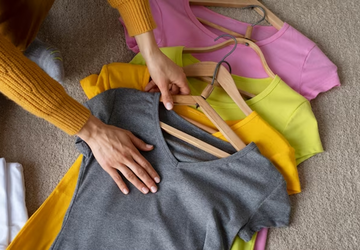health
In today's world, where sustainability and reducing waste are paramount concerns, recycling clothes has emerged as a crucial aspect of responsible consumption. Instead of allowing your old garments to languish in the depths of your closet or exacerbating the textile waste problem, it's essential to explore the Top Clothing Recycling Methods.
These methods not only diminish your environmental impact but also breathe new life into your fashion items. In this article, we'll delve into the Best Ways to Recycle Fashion, providing you with valuable insights to make a positive and eco-conscious contribution to our planet. Whether it's donating to charity, hosting clothing swaps, upcycling, using clothing recycling bins, relying on textile recycling facilities, or selling your clothes, you'll discover a range of options to suit your sustainable fashion goals.

1. Donate to Charity
Donating your gently worn clothing items to charity organizations is not only accessible but also immensely impactful. It's a simple yet powerful way to make a positive change, benefiting those in need and promoting sustainability. Whether you choose to donate to local charities, thrift stores, or well-known organizations like Goodwill or The Salvation Army, your contribution goes a long way in extending the life of your clothes and supporting a worthy cause. It's a win-win situation that allows you to declutter responsibly and make a meaningful difference in your community.
○ Helps those in need.
○ Reduces textile waste.
○ Supports charitable organizations.
○ May be eligible for tax deductions.
Donating to charity is a win-win situation. Your unwanted clothing finds a new home, and you contribute to a more sustainable and compassionate world. Plus, in some cases, you may be eligible for tax deductions for your charitable contributions, so keep your receipts.
2. Clothing Swaps
Hosting or participating in clothing swaps is an excellent way to recycle clothes while refreshing your wardrobe. Gather friends, family, or even your local community for a fun exchange of fashion items. What you no longer need might be someone else's treasure. It's a sustainable and social way to give and receive clothing.
○ Promotes sustainable fashion.
○ Encourages social interactions.
○ Saves money on new purchases.
○ Reduces textile waste.
Clothing swaps are not only eco-friendly but also budget-friendly. Instead of buying new clothes, you can find "new-to-you" items through swaps, reducing the demand for new clothing production.
3. Upcycling and DIY Projects
Get creative by upcycling your old clothing items. Upcycling involves transforming old pieces into something new and fashionable. You can turn jeans into shorts, add patches to jackets, or create unique accessories from fabric scraps. The possibilities are endless, and it's a fantastic way to breathe new life into your fashion pieces.
○ Adds a personal touch to your wardrobe.
○ Reduces the need for new purchases.
○ Minimizes textile waste.
○ Sparks creativity.
Upcycling not only extends the lifespan of your clothes but also allows you to express your personal style through custom creations. It's a sustainable and artistic approach to recycling fashion.
4. Recycling Bins and Textile Collection Programs
In numerous communities, you'll find the presence of clothing recycling bins or textile collection programs aimed at promoting sustainability and reducing textile waste. These conveniently located bins are often situated in easily accessible areas, such as parking lots or shopping centers. The concept is simple: you can deposit your unwanted clothing items into these bins, and they will be collected and carefully sorted for recycling or repurposing. This environmentally responsible approach ensures that your old clothes don't end up in landfills, instead finding new life through recycling processes or benefiting those in need. It's a small effort with a significant impact on our planet's well-being.
○ Convenient drop-off locations.
○ Supports textile recycling efforts.
○ Reduces textile waste.
Using clothing recycling bins is a hassle-free way to ensure that your old clothes are properly recycled. Check with your local government or recycling centers to find the nearest drop-off locations.
5. Textile Recycling Facilities

For clothing that's no longer suitable for donation or upcycling, consider textile recycling facilities. These specialized facilities have the equipment and expertise to process textiles, breaking them down into fibers that can be used to create new textiles or other products.
○ Diverts textiles from landfills.
○ Promotes circular fashion.
○ Supports textile recycling industry.
○ Reduces environmental impact.
Textile recycling facilities play a crucial role in closing the fashion waste loop. They prevent textiles from ending up in landfills and contribute to the creation of more sustainable fashion materials.
6. Sell Your Clothes
If you find yourself with clothing items that are still in excellent condition and you're looking to declutter your wardrobe while making some extra money, consider the option of selling them online or at local consignment shops. Thanks to platforms like eBay, Poshmark, and Depop, the process of listing and selling your fashion pieces has become incredibly convenient. By choosing to sell your clothes, you not only give your items a second life but also provide someone else with the opportunity to enjoy and cherish them. It's a sustainable and mutually beneficial way to part with clothing you no longer need.
○ Earn money from your old clothes.
○ Reduce clothing waste.
○ Give your items a second home.
○ Support the secondhand market.
Selling your clothes is a sustainable way to declutter your wardrobe and make room for new pieces. It also contributes to the growing popularity of the secondhand fashion market, promoting sustainable consumption.
Conclusion
Recycling your clothes is a small yet impactful step you can take to contribute to a more sustainable and environmentally friendly fashion industry. The Top Ways to Recycle Your Clothes discussed in this article offer a range of options to suit your preferences and values. Whether you choose to donate to charity, host clothing swaps, embark on upcycling projects, use clothing recycling bins, rely on textile recycling facilities, or sell your clothes, you're helping reduce textile waste and promote a circular fashion economy. It's time to give your old clothes a new purpose and make a positive difference in the world of fashion.

